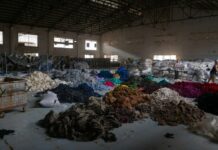The decision to implement a 30% tariff on European Union (EU) exports by President Trump has sparked significant alarm within the textile and fashion sectors. This policy poses a considerable threat to the EU’s second-largest export market, raising concerns among industry experts about its far-reaching implications.
At the heart of the issue is the €7.4 billion in EU textile and fashion exports that are directly affected by the tariff. The introduction of this tax could lead to an additional €2.2 billion in costs that need to be absorbed, creating a dilemma for stakeholders. The burden could fall on either American consumers or European exporters, but the reality is that both sides are likely to feel the financial strain. If the tariff situation remains unresolved, EU businesses may have to reassess their market presence in the US, which serves as a crucial destination for their exports.
In response to the changing trade dynamics, manufacturers from China and other Asian nations are increasingly diverting their focus to the European market. This shift has resulted in a flood of low-cost goods, creating an oversupply that threatens the viability of European producers. As these cheaper alternatives enter the market, the competitiveness of the EU textile and fashion industry diminishes, complicating the survival prospects for local businesses.
Moreover, the uncertainty surrounding the tariff implementation is impacting consumer confidence. With rising unpredictability, shoppers may delay purchasing decisions, leading to decreased demand for fashion items. This shift is likely to result in a significant downturn in sales for European retailers, who are preparing for challenging times ahead.
In light of these developments, the European Apparel and Textile Confederation (EURATEX) is urgently urging EU and US leaders to collaborate and find a mutually beneficial solution. As the deadline of August 1 approaches, EURATEX emphasizes the need for a win-win agreement to prevent further deterioration of the situation.


































